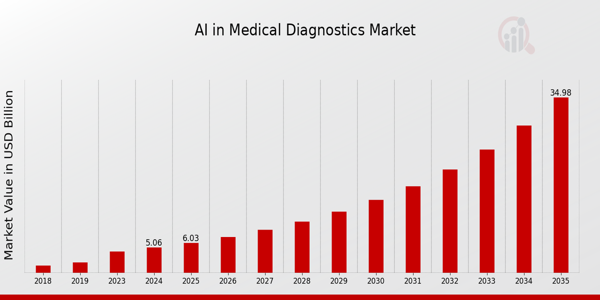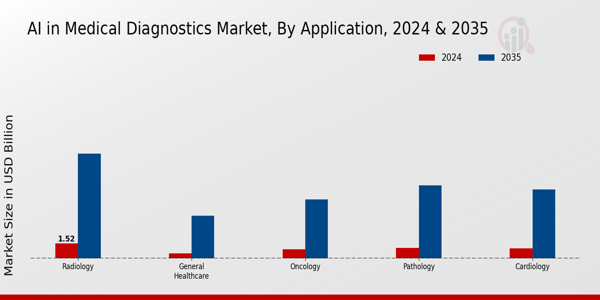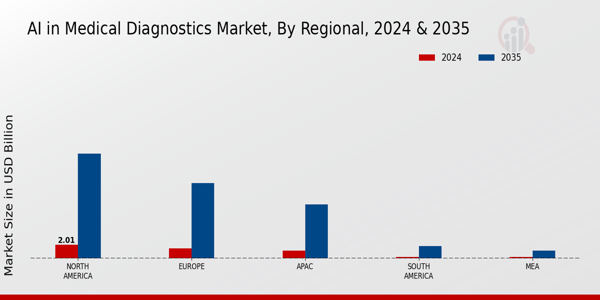AI in Medical Diagnostics Market Overview:
As per MRFR analysis, the AI in Medical Diagnostics Market Size was estimated at 4.24 (USD Billion) in 2023. The AI in Medical Diagnostics Market Industry is expected to grow from 5.06(USD Billion) in 2024 to 35 (USD Billion) by 2035. The AI in Medical Diagnostics Market CAGR (growth rate) is expected to be around 19.22% during the forecast period (2025 - 2035).
Key AI in Medical Diagnostics Market Trends Highlighted
Significant advancements in the Global AI in Medical Diagnostics Market are being driven by key market drivers, including the increasing demand for efficient and accurate diagnostic solutions, rising healthcare costs, and the increasing prevalence of chronic diseases. There has been a significant increase in the adoption of AI solutions to enhance diagnostic accuracy and patient outcomes, as governments worldwide are emphasizing the integration of advanced technologies in healthcare settings. AI algorithms are increasingly being employed in image analysis, such as radiology and pathology, to assist healthcare professionals in the early detection of maladies. Moreover, there are numerous opportunities to be investigated in the field of AI in medical diagnostics, particularly in the development of predictive analytics tools that can aid in personalized medicine. There is an increasing demand for solutions that not only offer real-time analysis but also predictive insights based on patient data as healthcare systems continue to evolve. An additional opportunity for superior health surveillance and proactive disease management is presented by the potential to integrate AI with wearable health technologies. Regulatory bodies have been establishing guidelines for the approval and use of AI technologies in clinical settings in recent times, which is a notable trend.

Source: Primary Research, Secondary Research, MRFR Database and Analyst Review
AI in Medical Diagnostics Market Drivers
Increasing Demand for Precision Medicine
The Global AI in Medical Diagnostics Market Industry is experiencing significant growth driven by the increasing demand for precision medicine. Precision medicine aims to tailor treatments and diagnostic procedures to individual patient characteristics, which necessitates advanced diagnostic tools. A report from the World Health Organization highlights a 25% increase in precision medicine usage worldwide over the past five years, reflecting a growing inclination among healthcare providers to adopt personalized approaches.Leading institutions such as the National Institutes of Health are investing heavily in research initiatives aimed at integrating Artificial Intelligence into diagnostic processes to enhance accuracy and efficiency. This wave of investment is expected to bolster the Global AI in Medical Diagnostics Market as healthcare systems increasingly adopt sophisticated diagnostic methodologies to provide better patient outcomes.
Technological Advancements in AI Algorithms
The evolution of Artificial Intelligence algorithms has significantly influenced Global AI in Medical Diagnostics Market Industry, with advancements leading to improved diagnostic accuracy and speed. Recent developments in machine learning and deep learning technologies have paved the way for AI applications in imaging diagnostics and disease prediction. For instance, the introduction of convolutional neural networks has been shown to enhance image recognition capabilities by over 15%, as reported by various leading tech universities.Notably, organizations like IBM Watson Health are at the forefront, demonstrating the potential of AI to analyze vast datasets for faster and more reliable diagnostics. The rise of these technologies has established a robust framework that supports and enhances diagnostic practices globally.
Rising Need for Remote Healthcare Solutions
The surge in telemedicine has played a pivotal role in driving the Global AI in Medical Diagnostics Market Industry. With healthcare demand transitioning towards remote solutions, especially after global disruptions like the COVID-19 pandemic, telemedicine has become an essential part of medical diagnostics. According to a recent report by the Centers for Disease Control and Prevention, telehealth visits rose by 154% in the last two years, prompting healthcare providers to integrate AI-based solutions to improve the efficiency of remote diagnostics.Organizations such as the American Telemedicine Association are advocating for technologies that enable remote patient monitoring, leading to a heightened interest in AI-powered diagnostic tools within the medical community worldwide. This shift supports the growth trajectory of the Global AI in Medical Diagnostics Market.
AI in Medical Diagnostics Market Segment Insights:
AI in Medical Diagnostics Market Application Insights
The Application segment of the Global AI in Medical Diagnostics Market has showcased substantial growth and diversification, reflecting the increasing incorporation of artificial intelligence technology across various healthcare applications. By 2024, the overall market is expected to be valued at 5.06 USD Billion, which is indicative of the rising demand for advanced diagnostic tools and solutions. This segment is notably supported by five primary categories that exhibit varying degrees of growth and adoption. Among these, AI in Radiology stands out as a significant contributor, projected to reach a valuation of 1.52 USD Billion in 2024 and escalate to 10.5 USD Billion by 2035, illustrating its majority holding in the market due to the critical role AI plays in image analysis and interpretation.Pathology follows closely, with expected values increasing from 1.05 USD Billion in 2024 to 7.3 USD Billion in 2035, owing to the integration of AI in enhancing diagnostic accuracy and efficiency through digital pathology solutions.
Cardiology, valued at 1.03 USD Billion in 2024 and projected to grow to 6.9 USD Billion by 2035, leverages AI to predict cardiovascular events and improve patient outcomes, thereby showing its significant impact on preventative healthcare measures. Oncology, while smaller in relative valuation, starting at 0.94 USD Billion in 2024 and expected to rise to 5.9 USD Billion by 2035, is nonetheless crucial as AI assists in identifying malignancies at earlier stages, which is pivotal in enhancing treatment efficacy.Lastly, the General Healthcare application, with a starting value of 0.52 USD Billion in 2024 and a projected reach of 4.3 USD Billion by 2035, demonstrates the broader applicability of AI in tracking general health trends, personalizing patient care, and improving operational efficiencies in healthcare systems.
The rapid advancements in machine learning algorithms and data analytics capabilities are driving this growth, enabling these sectors to enhance diagnostic precision while minimizing costs and time delays. As the Global AI in Medical Diagnostics Market continues to evolve, these segments not only highlight the importance of innovation in health technologies but also present considerable opportunities for investment, research, and scaling operational capabilities across the healthcare landscape.Overall, the continuous rise in the Global AI in Medical Diagnostics Market revenue exemplifies the trend towards digitization in healthcare, reflecting a broader global shift towards data-driven decision-making within medical diagnostics.

Source: Primary Research, Secondary Research, MRFR Database and Analyst Review
AI in Medical Diagnostics Market Technology Insights
The Global AI in Medical Diagnostics Market is expected to reach a valuation of 5.06 USD Billion in 2024, growing significantly as advancements in technology continue to shape healthcare. The market is driven by the increasing demand for efficient diagnostics solutions, with Machine Learning and Deep Learning playing pivotal roles in transforming data analysis and predictive modeling within medical applications. Machine Learning algorithms help in extracting valuable insights from large datasets, while Deep Learning techniques are crucial for image recognition tasks, allowing for advanced radiological evaluations.Natural Language Processing is essential for interpreting unstructured clinical data, enhancing decision-making processes, and automating documentation. Additionally, Computer Vision technology is vital for analyzing medical images, aiding in early disease detection and diagnosis. Technological innovations, the rising prevalence of chronic diseases, and the need for personalized healthcare solutions propel the overall market growth. However, challenges such as data privacy concerns and the need for regulatory compliance remain significant.The Global AI in Medical Diagnostics Market data reflect a robust trajectory driven by these technological advancements, showcasing a future where AI plays an integral role in improving patient outcomes and operational efficiencies within the healthcare landscape.
AI in Medical Diagnostics Market Deployment Mode Insights
The Global AI in Medical Diagnostics Market, particularly in the Deployment Mode segment, is witnessing significant growth as it evolves to meet the demands of healthcare providers globally. As of 2024, the overall market is valued at approximately 5.06 USD Billion and is projected to grow substantially until reaching 35.0 USD Billion by 2035. A critical aspect of this segment is its classification into Cloud-based, On-premises, and Hybrid deployment models. Cloud-based solutions are preferred due to their scalability, cost-effectiveness, and accessibility, significantly enhancing diagnostic capabilities.On-premises models are favored by larger healthcare institutions that prioritize data security and compliance, thus dominating in terms of control over sensitive information. Finally, Hybrid deployments combine both cloud and on-premises solutions, catering to diverse operational needs and providing flexibility. The Global AI in Medical Diagnostics Market's rapid growth is driven by factors such as advancements in machine learning, increased healthcare expenditures, and the demand for improved diagnostic accuracy. However, challenges like data privacy concerns and high implementation costs persist.The ongoing shift towards digital health solutions is creating ample opportunities for innovations in this segment, emphasizing the importance of diverse deployment modes in shaping the future of medical diagnostics.
AI in Medical Diagnostics Market End User Insights
The Global AI in Medical Diagnostics Market, valued at 5.06 USD Billion in 2024, shows significant potential for expansion, particularly within the End User segment. This segment encompasses various entities including Hospitals, Diagnostic Laboratories, Research Institutions, and Ambulatory Surgical Centers, each contributing uniquely to the market dynamics. Hospitals play a crucial role as they increasingly adopt AI solutions to enhance patient care and operational efficiency, making them a major player in this sector. Diagnostic Laboratories also hold a significant portion of the market as they utilize AI technologies for faster and more accurate test results, which improves diagnostic accuracy.Research Institutions are increasingly integrating AI into their workflows, facilitating advanced research and development in medical diagnostics, thereby reinforcing their importance. Ambulatory Surgical Centers are notable for their efficiency and patient-centered approach, using AI to streamline procedures and enhance outcomes. The overall market is characterized by a robust growth rate fueled by rising demand for improved diagnostic capabilities and the ongoing advancement of AI technology. Global AI in Medical Diagnostics Market revenue is poised for substantial growth, driven by innovation and increased applications across these key End Users.
AI in Medical Diagnostics Market Regional Insights
The Global AI in Medical Diagnostics Market is projected to experience substantial growth, challenging existing healthcare methodologies by enhancing diagnosis accuracy and efficiency. In 2024, the market valuation is at 5.06 USD Billion, with North America leading and holding a significant position at 2.01 USD Billion, exhibiting its dominance due to advanced healthcare infrastructure and technology adoption. Europe follows closely with a valuation of 1.48 USD Billion, benefitting from a robust Research and Development sector focused on innovative healthcare solutions.The APAC region, valued at 1.14 USD Billion in 2024, is on a growth trajectory, driven by increasing investments in healthcare technologies and rising healthcare demands. Meanwhile, South America and the MEA regions, valued at 0.22 USD Billion and 0.21 USD Billion, respectively, are potential growth markets due to emerging healthcare needs and improving technological access. Collectively, the Global AI in Medical Diagnostics Market segmentation illustrates varying degrees of market maturity and technological adoption, where North America and Europe take the lead. At the same time, APAC shows considerable potential and is rapidly gaining traction.

Source: Primary Research, Secondary Research, MRFR Database and Analyst Review
AI in Medical Diagnostics Market Key Players and Competitive Insights:
The Global AI in Medical Diagnostics Market is characterized by rapid advancements and a competitive landscape that is continuously evolving. The integration of artificial intelligence technologies into medical diagnostics has led to enhanced accuracy, efficiency, and cost-effectiveness in disease detection and management. A multitude of players, both established technology firms and innovative health startups, are participating in this market, creating a dynamic environment. The competition is fueled by the increasing demand for precision medicine, the growing emphasis on personalized healthcare, and the necessity to streamline clinical workflows while reducing diagnostic errors. As AI capabilities improve, the pursuit for market share has intensified, prompting companies to develop novel solutions that cater to a diverse range of medical needs and conditions.IBM has positioned itself as a leader in the Global AI in Medical Diagnostics Market through its robust portfolio and extensive market presence.
The company's strengths lie in its cutting-edge technologies, including Watson Health, which leverages AI and machine learning to assist healthcare professionals in making more informed decisions. IBM's commitment to improving patient outcomes and driving efficiencies within healthcare systems enhances its reputation as a trusted partner for healthcare institutions globally. The company's strategic collaborations with hospitals, research institutions, and universities further reinforce its foothold in the market by enabling the development of innovative diagnostic solutions that are both applicable and beneficial to real-world medical scenarios.Tempus has emerged as a significant player in the Global AI in Medical Diagnostics Market, specializing in data-driven precision medicine solutions.
The company offers a comprehensive range of products and services, including genomic sequencing and molecular analysis, which are integral to identifying the most effective treatment pathways for patients. Tempus's strengths are rooted in its ability to harness vast amounts of clinical and molecular data, providing physicians with insights that facilitate personalized treatment plans. The company's strategic mergers and acquisitions, aimed at expanding its capabilities and enhancing its data analytics technologies, position it strongly within the market. By focusing on integrating AI-driven diagnostics into clinical practice, Tempus not only improves its service offerings but also significantly contributes to the advancement of personalized medicine on a global scale.
Key Companies in the AI in Medical Diagnostics Market Include:
- IBM
- Tempus
- PathAI
- Philips
- GE Healthcare
- Google
- Aidoc
- Zebra Medical Vision
- Microsoft
- CureMetrix
- Enlitic
- Freenome
- Siemens Healthineers
AI in Medical Diagnostics Market Industry Developments
The Global AI in Medical Diagnostics Market has seen significant developments recently, with several companies making headlines. IBM has been leveraging its Watson Health platform to enhance diagnostic capabilities, while Tempus is focusing on integrating AI in genomic data analysis to improve patient outcomes. PathAI, known for its work in pathology, has made strides with partnerships to broaden its AI capabilities. Recent advancements by GE Healthcare and Philips in imaging technologies illustrate the growing emphasis on AI's role in enhancing imaging diagnostics. In terms of mergers and acquisitions, in September 2023, Aidoc announced its acquisition of Zebra Medical Vision to strengthen its product offerings in radiology AI.
Additionally, Microsoft has been actively collaborating with healthcare providers to expand its AI tools in diagnostics. Notably, the market has experienced substantial growth, driven by an increasing demand for precision medicine and the ability to process vast amounts of data quickly. This uptrend in investment and innovation within the Global AI in Medical Diagnostics Market highlights an ongoing commitment to improving healthcare delivery while addressing challenges in diagnostic accuracy and speed. In the past 2-3 years, there has been a sustained increase in the adoption of AI technologies across various sectors of healthcare.
AI in Medical Diagnostics Market Segmentation Insights
AI in Medical Diagnostics Market Application Outlook
- Radiology
- Pathology
- Cardiology
- Oncology
- General Healthcare
AI in Medical Diagnostics Market Technology Outlook
- Machine Learning
- Deep Learning
- Natural Language Processing
- Computer Vision
AI in Medical Diagnostics Market Deployment Mode Outlook
- Cloud-based
- On-premises
- Hybrid
AI in Medical Diagnostics Market End User Outlook
- Hospitals
- Diagnostic Laboratories
- Research Institutions
- Ambulatory Surgical Centers
AI in Medical Diagnostics Market Regional Outlook
- North America
- Europe
- South America
- Asia Pacific
- Middle East and Africa
| Report Attribute/Metric Source: |
Details |
| MARKET SIZE 2023 |
4.24(USD Billion) |
| MARKET SIZE 2024 |
5.06(USD Billion) |
| MARKET SIZE 2035 |
35.0(USD Billion) |
| COMPOUND ANNUAL GROWTH RATE (CAGR) |
19.22% (2025 - 2035) |
| REPORT COVERAGE |
Revenue Forecast, Competitive Landscape, Growth Factors, and Trends |
| BASE YEAR |
2024 |
| MARKET FORECAST PERIOD |
2025 - 2035 |
| HISTORICAL DATA |
2019 - 2024 |
| MARKET FORECAST UNITS |
USD Billion |
| KEY COMPANIES PROFILED |
IBM, Tempus, PathAI, Philips, GE Healthcare, Google, Aidoc, Zebra Medical Vision, Microsoft, CureMetrix, Enlitic, Freenome, Siemens Healthineers |
| SEGMENTS COVERED |
Application, Technology, Deployment Mode, End User, Regional |
| KEY MARKET OPPORTUNITIES |
Advanced imaging technologies integration, Enhanced patient data analytics, Predictive analytics for disease prevention, Personalized treatment solutions, Cost-effective diagnostic solutions |
| KEY MARKET DYNAMICS |
Technological advancements in AI, Increasing prevalence of diseases, Growing demand for efficient diagnostics, Rising healthcare expenditures, Enhancements in imaging technologies |
| COUNTRIES COVERED |
North America, Europe, APAC, South America, MEA |
Frequently Asked Questions (FAQ) :
The Global AI in Medical Diagnostics Market is expected to be valued at 5.06 USD Billion in 2024.
By 2035, the Global AI in Medical Diagnostics Market is projected to reach a value of 35.0 USD Billion.
The expected CAGR for the Global AI in Medical Diagnostics Market from 2025 to 2035 is 19.22%.
North America is expected to dominate the market with a value of 2.01 USD Billion in 2024.
The market size for Radiology application is expected to reach 10.5 USD Billion by 2035.
The Pathology application is valued at 1.05 USD Billion in the year 2024.
Key players in the market include IBM, Tempus, PathAI, Philips, and GE Healthcare, among others.
The Cardiology segment is expected to be valued at 6.9 USD Billion by 2035.
The General Healthcare segment is projected to be valued at 0.52 USD Billion in 2024.
The APAC region is projected to reach a market value of 7.89 USD Billion by 2035.

















